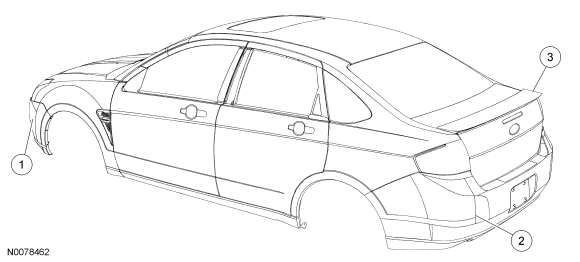Ford Focus Service Manual: Plastic Components - Description and Operation
Exterior Plastics — Painted
 WARNING: Always
WARNING: Always
refer to Material Safety Data Sheet (MSDS) when handling chemicals and wear protective
equipment as directed. Examples may include but are not limited to respirators and
chemically resistant gloves. Failure to follow these instructions may result in
serious personal injury.
NOTE:
The following illustration(s) are not all-inclusive of trim levels available. The actual trim level of the vehicle will determine the viability of carrying out a plastic repair.

| Item | Part Number | Description |
|---|---|---|
| 1 | 17D957 | Bumper cover (front) — Thermoplastic Olefin (TPO) |
| 2 | 17K835 | Bumper cover (rear) — TPO |
| 3 | 44210 | Decklid spoiler — Acrylonitrile Butadiene Styrene (ABS) |
Several considerations will determine viability of plastic repair procedure(s):
- Is the damage cosmetic or structural?
- Can the repair be carried out on the vehicle?
- Is the part readily available?
- Is component repair the most cost effective method?
- Can the component be economically restored to original strength and appearance?
- Will the repair provide for the fastest, highest quality repair?
Several types of plastic are in use for automotive application. However, all plastics will fall into 2 primary categories of thermoplastic or thermosetting plastic.
Thermosetting Plastic
Generally, thermosetting plastics are made with 2-part thermosetting resins. When mixed together, heat is generated, producing a cure that is irreversible. Because of this, thermosetting plastics will require the use of a 2-part adhesive for repair.
Sheet-Molded Composite (SMC)
Sheet-Molded Composite (SMC) is a type of thermosetting plastic that uses glass fibers or nylon fibers in combination with thermosetting polyester resins. When fully cured, SMC is strong and rigid.
SMC is similar, but not identical, to fiberglass. Ford Motor Company uses SMC in components such as fenders, hoods and liftgates.
Thermoplastic Compounds
Thermoplastic compounds are manufactured by a process that is reversible. Thermoplastics can be remolded repeatedly by reheating. This characteristic of thermoplastics makes plastic welding a possible repair alternative. A repair of thermoplastic compounds is still possible through the use of 2-part adhesive and filler repair materials and reinforcements as needed. Thermoplastics are widely used in interior trim components, wheel flares, body side cladding and bumper covers.
Polyolefin
Polyolefins fall into the family of thermoplastics with one unique characteristic: an oily or waxy feel to the material when sanded or ground. Polyolefin lends itself very well to remolding through the use of heat. Because of this, components made of this material lend themselves well to the possibility of plastic welding. Most adhesive repair materials and paint will not bond to surface of a polyolefin unless an adhesion promoter specially formulated for plastic is first applied to the exposed raw surface. Otherwise, polyolefins are repaired like most other thermoplastics. Some typical uses of polyolefins are bumper covers, fan shrouds and wheel housings.
Correct identification of the various types of plastic is necessary to select the appropriate repair method(s) to carry out high quality plastic repairs. Refer to Plastics Identification in this section.
 Body Sealer Types And Applications - Description and Operation
Body Sealer Types And Applications - Description and Operation
Seam Sealer
Seam Sealer TA-2 or equivalent:
is a heavy-bodied, non-sag adhesive/sealer for use on standing cosmetic
seams, truck bed seams, tooled door skin seams and floor pans.
can be u ...
 Plastics Identification - General Procedures
Plastics Identification - General Procedures
WARNING: Always
refer to Material Safety Data Sheet (MSDS) when handling chemicals and wear protective
equipment as directed. Examples may include but are not limited to respirators and
chemical ...
More about Ford Focus:
Ford Focus Valve Stem to Valve Guide Clearance
Special Tool(s)
Clearance Gauge, Valve Guide
303-004 (TOOL-6505-E) or equivalent
Dial Indicator Gauge with Holding Fixture
100-002 (TOOL-4201-C) or equivalent
NOTE: Refer to the appropriate Section 303-01 for the specification.
NOTE: The v ...
